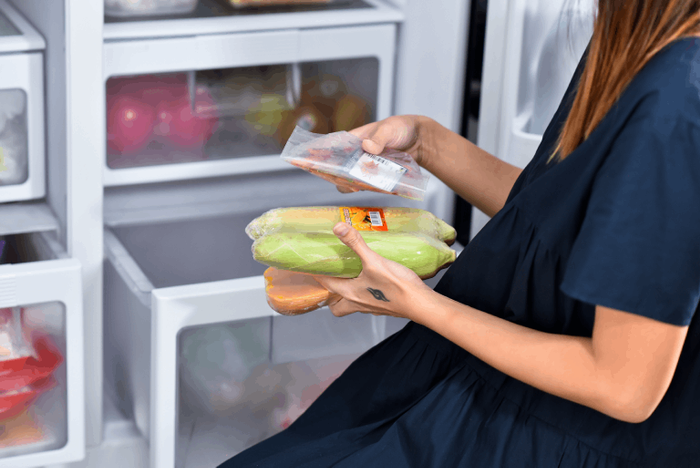A clean fridge is a healthy fridge.
How do you store fresh produce in your fridge? Do you simply chuck them in or do you (re)pack them in bags or containers to extend their shelf life?
Storing food right prevents food wastage and help you save money in the long run. Here are some things you can do to improve shelf life.
1. Separate your fruits and vegetables

Image credit: Hitachi Singapore
If you ever wonder why your greens turn yellow so quickly despite storing them in the fridge, your juicy produce might be the culprit. Fruits such as apples, bananas and avocados emit ethylene gas that causes other crops to decay at a more rapid rate. Hence, it’s recommended to store fruits and veggies in separate compartments to ensure optimal freshness.
Or simply place your fruits in a bowl on the table, away from other ethylene-sensitive produce. As the saying goes, one rotten apple spoils the whole bunch!
2. Use paper towels and containers to keep moisture out

Image credt: Style Degree
Moisture can accelerate food spoilage and encourage bacterial growth, and it doesn’t help that vegetables, especially leafy greens like kale and lettuce, have a relatively short shelf life.
One handy trick is to wrap them in a damp paper towel to absorb the excess moisture so your veggies can be kept fresh and crisp for longer. (Pro tip: don’t wash produce until you refrigerate it as that will add to the moisture content!) You can then seal them in a loose plastic baggie, silicone storage bags, or food containers with an airtight seal before keeping them in the fridge.
3. Avoid dairy products by the door

Image credit: Flamingo Appliance
The act of opening and closing a fridge can cause the temperature of the door to be warmer than the other compartments – which is not ideal for food that needs to be kept chilled, especially for dairy products. To avoid premature spoilage, store your milk on the middle or bottom shelves to keep it nice and cold.
The same goes for eggs, which should be kept on a shelf in the back of your fridge instead of by the door.
4. Do not overcrowd your fridge

Image credit: Hitachi Singapore
Most homeowners make the common mistake of always filling the fridge to the brim. Packing a fridge too tightly can end up hindering its air circulation and cooling ability, which may speed up the decaying process as food is not maintained at its proper temperature. This also means that your fridge has to use up a lot more energy in order to keep the items within cold, and that spells bad news for your electricity bills.
A rule of thumb is to keep it two-thirds filled!

Image credit: Hitachi Singapore
For those who are guilty of stockpiling, perhaps it’s time to do a clean out. Start by decluttering your fridge – this helps to maximise efficiency and streamline your shelf space so overcrowding doesn’t happen. Make an effort to clear out expiring products every few months. One way to keep track of your contents is to practice the “first in, first out” method; put new groceries at the back, and move the old ones to the front so you know what needs to be thrown out/consumed before it goes bad.
5. Clean your fridge

Image credit: Amazon.com
With raw and cooked ingredients placed together, chances of bacteria multiplying are high. If your fridge starts to smell from leftovers (or even raw food), your interior probably needs a good scrubbing sesh to get rid of the odour. Remove the shelves and drawers, and use soapy water to rinse it down thoroughly before drying all surfaces and placing everything back into the fridge.
Then, deodorise your fridge by leaving an open container with baking soda in the fridge for 24 hours to remove excess moisture in the fridge. If all else fails, a store-bought deodoriser does the job too.
With these storage and maintenance tips in mind, you’re now all prepped for your next grocery haul!

 Get a budget estimate before meeting IDs
Get a budget estimate before meeting IDs